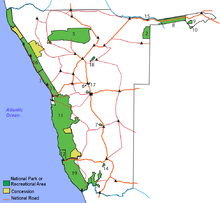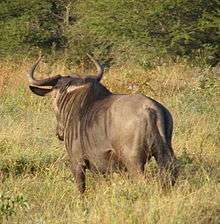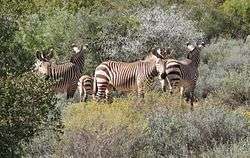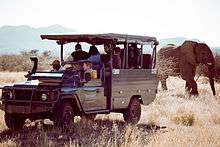Protected areas of Namibia

The protected areas of Namibia include its national parks and reserves. With the 2010 declaration of Dorob National Park, Namibia became the first and only country to have its entire coastline protected through a national parks network.[1] Protected areas are subdivided into game reserves and/or nature reserves, such as special protected area, wilderness areas, natural areas, and development areas. There are also recreation reserves.[2] Facilities in the national parks are operated by Namibia Wildlife Resorts.[3] Over 19% of Namibia is protected, an area of some 130,000 square kilometres.[4] However, the Ministry of Environment & Tourism auctions limited hunting rights within its protected areas.[4] The Namibia Nature Foundation, an NGO, was established in 1987 to raise and administer funds for the conservation of wildlife and protected area management. Communal Wildlife Conservancies in Namibia help promote sustainable natural resource management by giving local communities rights to wildlife management and tourism.
National parks
| Image | Name | Established | Area (km2) | Summary |
|---|---|---|---|---|
 | Bwabwata National Park | 2007 | 6100 | The NP includes the Mahango Game Park and Caprivi Game Park. Vegetation consists of tree and shrub savannah biome such as Zambezi teak (Baikiaea plurijuga), wild seringa (Burkea africana), and African teak (Pterocarpus angolensis). Some of the larger mammals include the African buffalo, hippopotamus, roan antelope, and predators are Katanga lion, leopard, Namibian cheetah and spotted hyena. Important bird species include black-winged pratincole and slaty egret.[5][6][7] |
 | Dorob National Park | 2010 | 57772 | Dorob NP, meaning "dry land", is a 1,600 kilometres (990 mi) long strip of land, encompassing belts of coastal dunes and gravel plains, as well as Ramsar listed wetlands. With the park's creation the coastline from the Kunene River on the Angolan border to the Orange River on the South African border become a solid barrier of parks.[8] |
 | Etosha National Park | 1907 | 22220 | The Etosha salt pans are the most noticeable geological features in the park. Vegetation types are mostly of woodland (mopane, the most common tree) and also savanna, grasslands and saline desert. There are about 114 mammal species, 340 bird species, 110 reptile species, 16 amphibian species and 1 species of fish (up to 49 species of fish during floods.) Mountain zebra is found in the largest numbers (2235).[12] |
 | Khaudom National Park | 3657.91 | The dominant vegetation in the park, which is located in the Kalahari Desert is species-rich, high and short dry forest and dry acacia forest. Large mammals in the park include more than 3500 elephants, giraffes and antelopes, including horse antelopes, kudus, lyre antelopes, elands and reedbucks. 320 species of birds inhabit the area, including parrots and more than 50 birds of prey.[8] | |
 | Mamili National Park renamed Nkasa Rupara National Park in 2012 | 1 March 1990 | 343.17 | The dominant flora is broadleaved trees and can be described as a Savanna biome and the vegetation type is Caprivi floodplains. Some of the mammals found include the African elephant, the African buffalo (about 1,000 head of population), hippopotamus (560) and crocodile (500). Around 450 bird species have also been reported.[13][14] |
| | Mudumu National Park | 1990 | 737 | This park is an important migration route of African elephant and many other large animals from Botswana to Angola. 430 bird species, including African fish eagle, African skimmer and western-banded snake eagle have been reported. Fish species in the park include the tiger fish and tilapia.[15] |
| | Namib-Naukluft National Park | 1 August 1979 | 49,768 | The Namib Desert (considered the world's oldest desert) and the Naukluft mountain range are part of the park. The desert dunes taper off near the coast, and lagoons, wetlands, and mudflats. In the hyper-arid region faunal species reported are snakes, geckos, unusual insects, hyenas, gemsboks and Black-backed jackals.[16][17] |
| Skeleton Coast National Park | 1971 | 16,845 | Designated in 1971, this park gets its name from the skeletal remains of shipwrecks which are a numerous occurrence on this stretch of coastline. There are elephants which live in desert dunes and Southwest African lions in the park. Springbok, plains zebra, gemsbok, jackals and ostrich are also reported. In the offshore part of the park, dolphins and whales are sighted.[18] | |
 | Waterberg National Park | 1972 | 405 | Several of Namibia's endangered species were moved into this waterberg park (waterberg means "hill of water") for conservation. In 1989, black rhinoceros was reintroduced to the area from Damaraland. Sable, rone antelope, red heartebeest and steenbok are reported in the park. The lower hills of the mountain have over 200 species of bird with some rare species of small antelope. Some of the key bird species are black eagles, peregrine falcons and Cape vulture.[19] |
Nature reserves
Brandberg Nature Reserve

Brandberg Nature Reserve is located in Damaraland and surrounds the entire Brandberg Mountain massif, the highest mountain in Namibia which 175 kilometres north of Swakopmund.[20] It became a nature reserve in 1951.[21] The Ugab River flows in the area.[22]
Cape Cross Seal Reserve

Cape Cross is a protected area under the name Cape Cross Seal Reserve. The reserve is the home of one of the largest colonies of Cape fur seals in the world.[23] Cape Cross is one of two main sites in Namibia where seals are culled, partly for selling their hides and partly for protecting the fish stock. The economic impact of seals on the fish resources is controversial: While a government-initiated study found that seal colonies consume more fish than the entire fishing industry can catch,[24] animal protection society Seal Alert South Africa estimated less than 0.3% losses to commercial fisheries.[25]
Caprivi Game Park
The Caprivi Game Park is located within Bwabwata NP. The reserve is 5,715 square kilometres (2,207 sq mi) in size. It is situated in the northeast of the country on the Caprivi Strip.[26] It is one of the wettest areas of the country, especially during the southern hemisphere winter months of December to March. The landscape consists mainly of swamps, floodplains, wetland, and deciduous woodland, especially wild seringa, copalwood and Zambezi teak, and is biologically rich with over 450 animal species such as elephant, roan, kudu, and buffalo, and over 400 species of birds.[26] Elephants are particularly populous in the western part of the Caprivi, where they flourish in the thick mixed vegetation and dunes.[27]
Daan Viljoen Game Reserve

The Daan Viljoen Game Reserve is a game reserve near Windhoek, situated in the hill area of Khomas Hochland.[20] Over 200 species are found here, typical of the Namibian highlands, including Hartmann's mountain zebra, blue wildebeest, kudu, gemsbok, springbok, impala, rockrunner, white-tailed shrike, Monteiro's hornbill, Bradfield's swift, Rüppell's parrot and Carp's tit.[20] In the 1990s a number of indigenous people in the area were resettled by the Namibian government.[20] The park has many walking paths and allows tourists to travel around by themselves. It closed in 2010 to allow for the construction of the Sun Karros Daan Viljoen Lodge but has since reopened.
Ehirovipuka Conservancy
Ehirovipuka Conservancy is a nature reserve situated in the Kunene Region. It was established in January 2001 and covers an area of 1,980 square kilometres (760 sq mi).[28] The reserve consists of mainly semi-desert and savannah woodlands, and the Ombonde River flows through the area.[28] Animals living there include African bush elephant, African leopard, Southwest African lion, South African cheetah, common eland, kudu, duiker, warthog, steenbok, gemsbok, Angolan giraffe, springbok, South African ostrich, and Hartman's mountain zebra.[28][29][30] It contains a meat processing plant supplying tourist lodges.[31] Other economic activity includes forestry and the sale of traditional craft products.[32] Ehirovipuka Conservancy received a 20-year tourism concession in 2010.[33][34]
Erindi Private Game Reserve
The Erindi Game Reserve ('Erendi' meaning "Place of Water") is in the heart land of Namibia and covers an area of 70,000ha. It is located 40 km to the east of Omaruru town and lies between the Erongo Mountain Rhino Sanctuary Trust of Namibia and the Omataku Mountains. Habitats recorded are of mountainous areas, riverine vegetation, inselbergs ("island mountains") and grassland savannahs. Leopard research is an important activity in the reserve. It also has a notable population of south-western black rhinoceros, lion, brown hyena, leopard and cheetah.[35]
Gamsberg Nature Reserve
Gamsberg Nature Reserve is in central Namibia, located west of Rehoboth. It surrounds Gamsberg, Namibia's fourth highest mountain, with a peak elevation of 2,347 metres (7,700 ft).[36]
Hardap Nature Reserve
Hardap Nature Reserve surrounds Namibia's largest Hardap Dam, which opened in 1964 as a recreational area.[37] Listed under IUCN Category IV,[37] as of 2004 the park it covered an area of 252 square kilometres (97 sq mi), of which about 10% formed the lake area.[36][38] As Reader's Digest said though, "ironically, although Hardap is one of Namibia's best-known resorts, the nature reserve is unfamiliar to the large majority of visitors."[39] It contains over 100 species of birds.[38]
Kaokoland Nature Reserve
The Kaokoland Nature Reserve is located in northwestern Namibia and is separated from the Atlantic Ocean by the Skeleton Coast National Park. Open to visitors throughout the year, the reserve extends over more than 10,000 km2 of wide grassy plains and mountain ranges. The reserve contains animals such as the elephant, black rhino, giraffe, springbok, lion and ostrich.
Kaudom Game Reserve
The Kaudom Game Reserve located in the extreme northeastern part of Namibia covers an area of 300 km2. Divided by the Kalahari Desert, it has dry forest vegetation such as omuramba and deciduous trees of rare wood. Many subterranean streams flow through the park. It has 64 mammal species; these are elephants, buffaloes, giraffes, blue wildebeest, kudu, gemsbok, elands, tsessebes, roan antelope, and many species of predators. There are also 300 species of birds which include birds of prey.[19][40]
Mahango Game Park
The Mahango Game Park was established in 1986. It is 250 square kilometres (97 sq mi) in size and is situated within the Bwabwata NP, and comprises a vast expanse of flood plains as part of the Okavango River basin. There are 300 bird species and very large baobab trees. It has 99 species of mammals considered the second most species-rich area in Namibia. There are 71 species (including two threatened species) of fish reported from the Kavango River that flows through the park.[41][42]
Naankuse Wildlife Sanctuary

The Naankuse Wildlife Sanctuary covers an area of 3,200 ha which is a sanctuary for orphaned animals. Some of the animals tended are lions, leopards, cheetahs, wild dogs, caracals and baboons. The animals reported in the wild of the sanctuary are giraffe, zebra, kudu, hartebeest, springbok, eland, jackal and also wild cheetahs and leopards.[43] The sanctuary has developed a new method to identify cheetahs in the wild based on their paw prints. This is done in association with Wildtrack, AfriCat and Chester Zoo.[44]
NamibRand Nature Reserve
The NamibRand Nature Reserve is a private nature reserve (largest such reserve in Africa) covering an area of 202,200 ha with four habitats of dunes and sandy plains, inselbergs and mountains gravel plains, and sand and gravel plains interface. The largest number of oryx gazelle (gemsbok or oryx) (3,200) and Antidorcas marsupialis (springbok) (12,400) are the dominant mammal species in the reserve. 150 bird species of birds are also reported. Other wild animals which are predators, recorded in the reserve are leopard, spotted and brown hyena, black-backed jackal, aardwolf, bat-eared fox, Cape fox, African wildcat, caracal and genet.[45][46]
Naukluft Mountain Zebra Park

The Naukluft Mountain Zebra Park was established in 1968. The Naukluftfarm was purchased and converted into the protected park with the objective of protecting the endangered Hartmann's mountain zebra. Based on an ecological survey in 1970 more private farms were purchased to establish a corridor of passage for gemsbok to travel between the dunes and the mountains. In 1979, Diamond Area 2 was also added. After the conservation effort was successful, the park was merged with the Namib Desert Park and the larger Namib-Naukluft Park covering an area of 23 340 km2 was established in 1986.[47]
Omaruru Nature Reserve
The Omaruru Nature Reserve in the National West Coast Recreation Area is a privately owned reserve. 'Omaru' means "bitter, thick milk" in Herero language and is a result of cattle eating bitter brush grown in the area, and then producing bitter milk. The plant is very sturdy and remains green even after all the other plants have become insipid or tasteless in the area.[48]
Palmwag Nature Reserve
The Palmwag Nature Reserve is in Northern Namibia and covers an area of 400,000 ha. The reserve has the largest population of black rhinos in Africa; a local organisation called Save the Rhino Trust protects them. Some of the wildlife reported are; leopards, lions, cheetas, mountain zebras, giraffes, springboks, kudus, and desert elephants.[49]
Popa Game Park
The Popa Game Park is a small park where the Popa water fall, which drops by only 3 m over rapids on the Okavango River, is situated. Its thunderous sound is heard over a long distance. Bird species are a common sight and hippopotamus inhabit the river.[40]
Tsaobis Leopard Park
The Tsaobis Leopard Park is the only nature reserve in Namibia to conserve leopards in particular.[50] Situated south of Omaruru and east of Swakopmund,[51] it was established in 1969.[52]
Transboundary Protected Areas

The protection is not necessarily limited to inside the borders of Namibia. In 2007 the Ai-Ais/Richtersveld Transfrontier Park, an international peace park, was created through the joint management of the Ai-Ais Hot Springs park, which includes parts of Fish River Canyon, and the Richtersveld National Park in neighbouring South Africa.[4] Fauna includes rock hyrax, ground squirrel, jackal buzzard and Hartmann's mountain zebra.
In 2006, the countries of Namibia, Angola, Zimbabwe, Zambia, and Botswana signed an agreement creating the Kavango–Zambezi Transfrontier Conservation Area (KaZa TFCA), a vast expanse of land designated primarily "'to establish a world-class transfrontier conservation area and tourism destination in the Okavango and Zambezi river-basin regions within the context of sustainable development", by linking different habitats and allowing animals the freedom of movement throughout this region of Africa.[4]
In addition, there is ongoing discussion between the governments of Namibia and Angola regarding the creation of a trans-border coastal park, formed from the concaternation of the Skeleton Coast National Park, and Angola's Iona National Park.[4]
References
- ↑ Dusenbery, Kelly. "Namibia". natureneedshalf.org. Retrieved 5 May 2013.
- ↑ World Conservation Monitoring Ce; IUCN Commission on National Parks and Protected Areas (1991). Protected Areas of the World: Afrotropical. – 1991. IUCN. pp. 210–. ISBN 978-2-8317-0092-2.
- ↑ Armstrong, Kate; Bainbridge, James; Firestone, Matthew D. (2010). Southern Africa 5. Lonely Planet. pp. 303–. ISBN 978-1-74059-545-2.
- 1 2 3 4 5 "Protected Areas". Ministry of Environment & Tourism.
- ↑ "Bwabwata National Park" (PDF). Ministry of Environment and Tourism.com. Retrieved 30 May 2013.
- ↑ "Bwabwata National Park". Official website of Namibia Tourism. Retrieved 30 May 2013.
- ↑ "Bwabwata Nationalpark" (in German). Namibia.de. Retrieved 30 May 2013.
- 1 2 "Khaumadam National Park" (PDF). Ministry of Environment Tourism. Retrieved 30 May 2013.
- ↑ Shangula, K. "Dorob National Park". Henties Bay Tourism Association.
- ↑ "A park of extremes – Dorob National Park". Travel News.Com. 2 August 2012. Retrieved 6 May 2013.
- ↑ "Dorob National Park". Travel News Namibi.com. Retrieved 6 May 2013.
- ↑ "Etosha National Park". Official Website of Namibia Tourism. Retrieved 7 May 2013.
- ↑ (PDF). Ministry of Environment and Tourism Namibia. 2012 http://www.met.gov.na/Documents/Mamili%20Park%20Profile.pdf. Retrieved 30 May 2013. Missing or empty
|title=(help) - ↑ . Windhoek, Namibia: Ministry of Environment and Tourism Namibia. 2010. p. 272. Missing or empty
|title=(help) - ↑ "Mudumu National Park" (PDF). Official Website of Government of Namibia. Retrieved 30 May 2013.
- ↑ "Namib Naukluft Park". Official website of Namib National Park. Retrieved 30 May 2013.
- ↑ "Namib-Naukluft National Park". NASA Earth Observatory. Retrieved 30 May 2013.
- ↑ "Skeleton Coast Park". Republic of Namibia – Ministry of Environment and Tourism. Archived from the original (PDF) on 5 June 2012. Retrieved 30 May 2013.
- 1 2 Nature's Strongholds: The World's Greatest Wildlife Reserves. Princeton University Press. 2005. p. 666. ISBN 978-0-691-12219-9. Retrieved 9 May 2013.
- 1 2 3 4 Tonchi, Victor L.; Lindeke, William A.; Grotpeter, John J. (31 August 2012). Historical Dictionary of Namibia. Scarecrow Press. p. 46. ISBN 978-0-8108-7990-4.
- ↑ Standard encyclopaedia of Southern Africa. NASOU. 1974. p. 155. Retrieved 8 May 2013.
- ↑ Logan, Richard F. (1960). The Central Namib Desert, South West Africa. National Academies. p. 156. NAP:00325.
- ↑ "Cape Cross – Namibia". Namibian.org. Retrieved 8 May 2013.
- ↑ Weidlich, Brigitte (28 June 2007). "Seal quota down for this season". The Namibian. Retrieved 8 May 2013.
- ↑ "Time for Namibia to see the tourism value of seals". The Namibian. 17 June 2010. Retrieved 8 May 2013.
- 1 2 "Caprivi Game Park". Etosha National Park. Retrieved 8 May 2013.
- ↑ Chase, Michael J. (2007). Home Ranges, Transboundary Movements and Harvest of Elephants in Northern Botswana and Factors Affecting Elephant Distribution and Abundance in the Lower Kwando River Basin. ProQuest. p. 85. ISBN 978-0-549-33284-8. Retrieved 8 May 2013.
- 1 2 3 "Ehi-Rovipuka Conservancy". NACSO. Retrieved 8 May 2013.
- ↑ "Rare Animals Extend Their Range". The Namibian. 17 September 2008. Retrieved 8 May 2013.
- ↑ "Hobatere's 'Old Boy' Killed". The Namibian. 8 November 2010. Retrieved 8 May 2013.
- ↑ "NWR's Dolomite Camp opens 2011". The Southern Times. 18 June 2010. Retrieved 8 May 2013.
- ↑ Bandyopadhyay, Sushenjit; Juan Carlos Guzman; Selma Lendelvo (January 2010). Communal conservancies and household welfare in Namibia (PDF) (Report). Directorate of Environmental Affairs, Ministry of Environment and Tourism. Retrieved 8 May 2013.
- ↑ "Govt approves concessions". The Namibian. 3 March 2010. Retrieved 8 May 2013.
- ↑ "Tourism Concessions Can Empower Rural Communities". Namibia Economist. 5 March 2010. Retrieved 8 May 2013.
- ↑ "Erindi Game Reserve". Namibia Reservations.com. Retrieved 9 May 2013.
- 1 2 Namibia Holiday & Travel. Advantage Travel Publications. 2004. Retrieved 8 May 2013.
- 1 2 IUCN Conservation Monitoring Centre; United Nations Environment Programme; Global Environmental Monitoring System (1 August 1987). IUCN directory of Afrotropical protected areas. IUCN. p. 452. Retrieved 8 May 2013.
- 1 2 Stuart, Chris; Stuart, Tilde (1997). Guide to Southern African Game & Nature Reserves. Passport Books. p. 287. ISBN 978-0-8442-8966-3. Retrieved 8 May 2013.
- ↑ Duggan, Alan; Hocking, Anthony (1 April 1993). Reader's digest illustrated guide to the game parks and nature reserves of Southern Africa. Reader's Digest Association of South Africa. p. 293. ISBN 978-0-947008-66-6. Retrieved 8 May 2013.
- 1 2 ebizguides (May 2008). Namibia. MTH Multimedia S.L. pp. 278–. ISBN 978-84-935202-1-2. Retrieved 9 May 2013.
- ↑ "Mahango National Park". Info Namibia.com. Retrieved 6 May 2013.
- ↑ "Mahango Game Reserve and Kavango River". Bird Life International Organization. Retrieved 6 May 2013.
- ↑ "Wildlife Sanctuary". Official website of Naankuse Sanctuary. Retrieved 9 May 2013.
- ↑ Bourton, Jody (23 September 2009). "Fingerprints' identify cheetahs". BBS Earth News. Retrieved 9 May 2013.
- ↑ "NamibRand Nature Reserve". Official website of Namibrand.org. Retrieved 9 May 2013.
- ↑ "NamibRand Nature Reserve Conservation". Official website of Namibrand.org. Retrieved 9 May 2013.
- ↑ "NAMIBIA – National Parks: Naukluft 4X4 Trail". New African Frontiers.com. Retrieved 9 May 2013.
- ↑ S. N. Stuart (1990). Biodiversity in Sub-Saharan Africa and Its Islands: Conservation, Management and Sustainable Use. IUCN. pp. 149–. ISBN 978-2-8317-0021-2. Retrieved 9 May 2013.
- ↑ David Anderson. On Safari. Focus on Africa Publications. pp. 556–. ISBN 978-0-620-29695-3. Retrieved 9 May 2013.
- ↑ Watching Wildlife: Southern Africa : South Africa, Namibia, Botswana, Zimbabwe, Malawi, Zambia. Lonely Planet. 2009. p. 115. ISBN 9781741042108.
- ↑ Google Maps (Map). Google.
- ↑ Hardy, Paula; Firestone, Matthew D. (15 February 2007). Botswana and Namibia. Lonely Planet. p. 244. ISBN 978-1-74104-760-8. Retrieved 18 August 2011.
External links
- Official website of the Republic of Namibia, Ministry of Environment & Tourism
| Wikimedia Commons has media related to Protected areas of Namibia. |

